
IT is still often seen as inflexible and costly
Digitalization has been at the top of the strategic agenda for over a decade (see Figure 1). IT assets, and the function that manages them, are usually seen as the backbone of the digitalization effort.
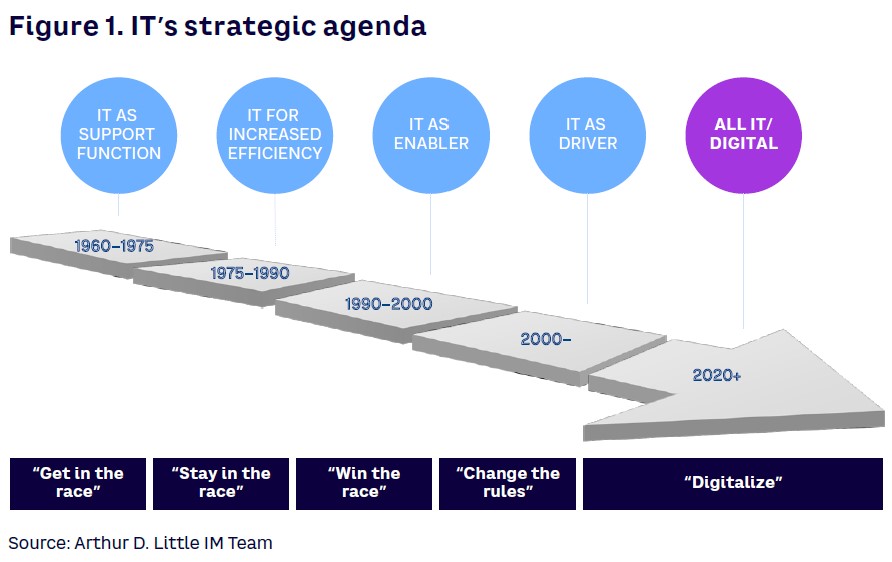
Yet there is still a lot of dissatisfaction with the value that IT provides. Company leadership often sees digitalization as a necessary but undesirable exercise, involving huge IT implementation projects lasting years and costing many millions, with IT spend increasing year on year as software licenses stack up. According to Arthur D. Little (ADL) research, some 70% of executives doubt that their IT function is able to lead the challenge of digitalization, and 90% are unclear what monetary value to place on their IT assets.
So how can the IT function raise its game to avoid these criticisms and create significantly more business value along the digitalization journey?
How IT creates business value
The starting point is to focus IT strategy clearly on the three fundamental ways that IT adds business value: efficiency, business alignment, and innovation (see Figure 2).
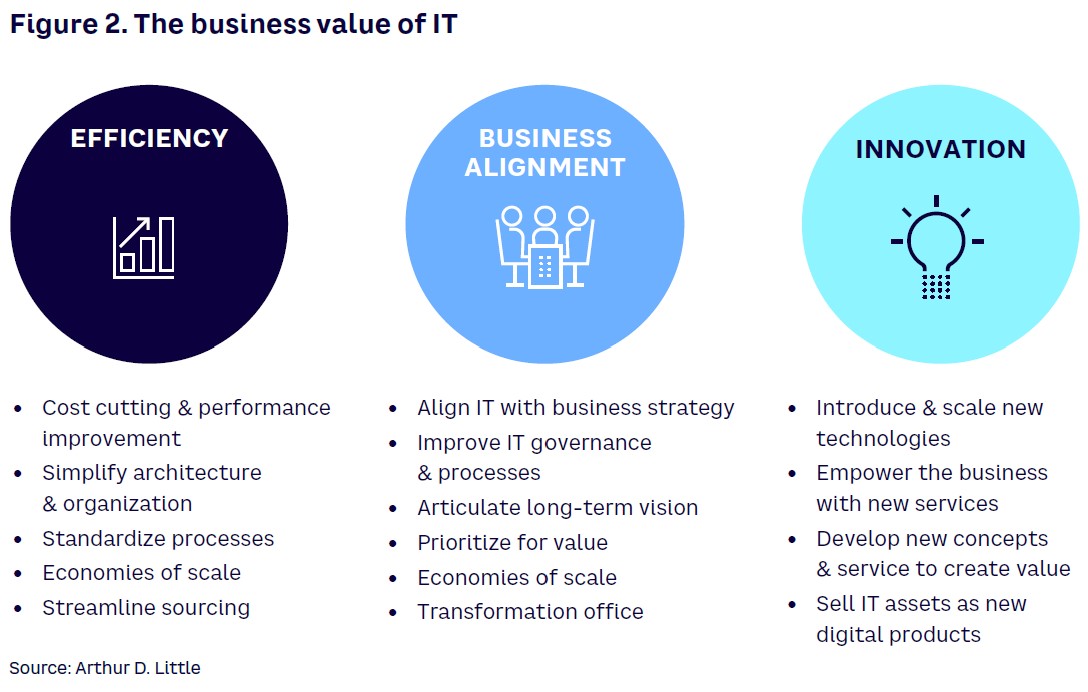
Efficiency is the first place to seek value. In a large company with more than a decade or two of history, there may be hundreds or even thousands of active IT systems offering huge potential for synergy and complexity reduction. Recent ADL research shows that having more than 80% of total IT costs incurred simply by running existing systems is a common pattern, as shown in the anonymized real case example illustrated in Figure 3.
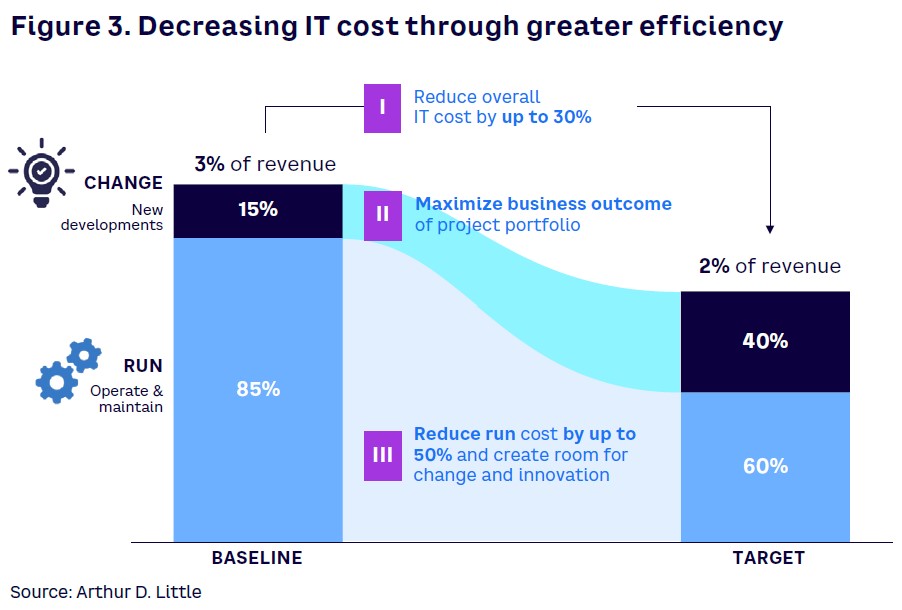
In this client example, it was possible to decrease running costs by as much as 50% by seeking areas for efficiency. Such areas, including cloud transformation, consecutively enabled application portfolio rationalization, economies of scale in IT procurement, cost/quality optimization, and off-/on-/near-/re-shoring optimization, enabled the client to free up significant budget and use those funds to invest in change and innovation.
Other sources of IT efficiency improvement include streamlining and centralizing key capabilities such as cloud and analytics into centers of excellence and revisiting outsourcing policy. While contract staff can provide useful resource flexibility and additional capabilities, using them over extended periods can become costly and ineffective. Instead, upskilling of in-house IT staff can improve service delivery and enable closer collaboration with the business.
IT efficiency requires attention to multiple aspects, including the application landscape, infrastructure and facilities, the supply chain, people and skills, and ways of working. A prerequisite for making changes is to be able to measure value transparently using business-driven KPIs, including costs, benefits, quality, and performance.
If efficiency is concerned with “doing things right,” business alignment focuses on “doing the right things.” Alignment of IT to enable digital transformation requires a comprehensive approach, starting with strategy and governance and including people and culture as well as technology. Because digitalization is so pervasive across multiple processes and activities, a big barrier to change is not knowing where to start and where to focus effort. One of the most effective ways to determine where to concentrate efforts is to use a digital heatmap, as shown in the example from a large global transportation and logistics company (see Figure 4).
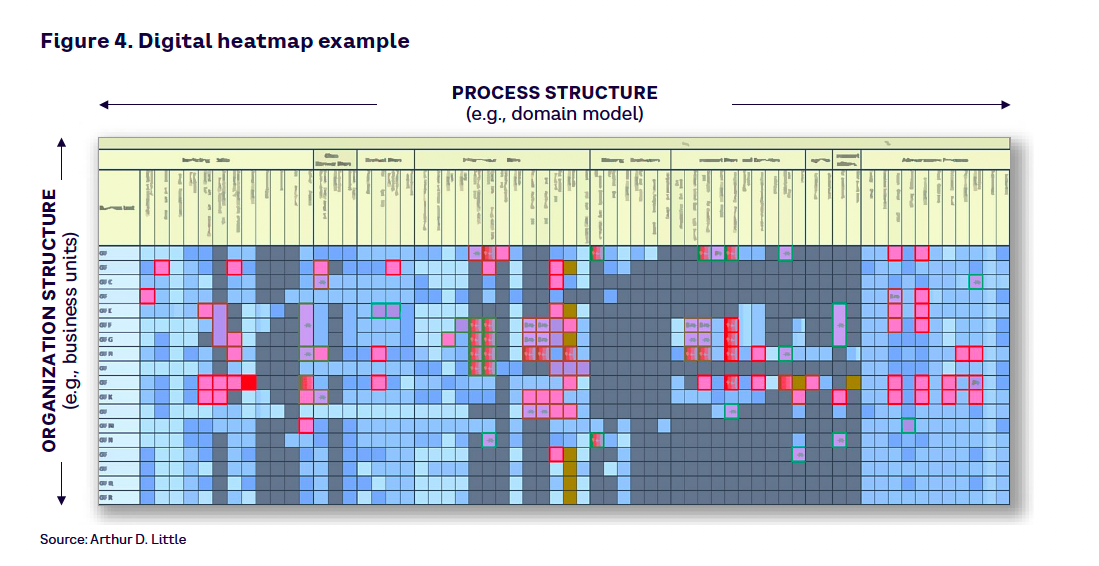
The heatmap identifies the scale of digital opportunities for each key process (x axis) across different business/organizational units (y axis) on a scale of 1 (light blue) to 9 (red). For example, a hot spot could be smart robots and video analytics for asset inspection, enabling faster and safer processing. Current digital initiatives can also be mapped onto the same matrix to identify gaps and misalignments.
The transformation process is likely to involve many aspects (e.g., decoupling architecture to capture value in legacy core systems while at the same time creating new digital capabilities). Agile structures also deliver huge benefits, but companies need to move beyond simply creating agile teams within a traditional hierarchy toward achieving agile at scale across the complete business unit or function. A single, unified digital governance approach is highly effective to drive progress. In all steps of the journey, active involvement of business teams together with IT is critical for success.
The third pillar of value in IT can be reached through innovation. For companies that are already some way along the IT value journey in terms of efficiency and alignment, it is this third aspect where there is still a great deal of untapped potential for value creation.
Creating IT value through innovation
Digital technology management suffers from some common flaws in large companies, for example:
- Overemphasis on retroactive technology utilization; reluctance to end what’s not working.
- Innovation getting stuck in the proof-of-concept (PoC) loop without getting as far as scaling.
- Failure to recognize new opportunities for digital assets to generate additional commercial revenues.
To address these flaws, the IT function needs to achieve mastery across all the elements of the digital technology innovation cycle (see Figure 5).
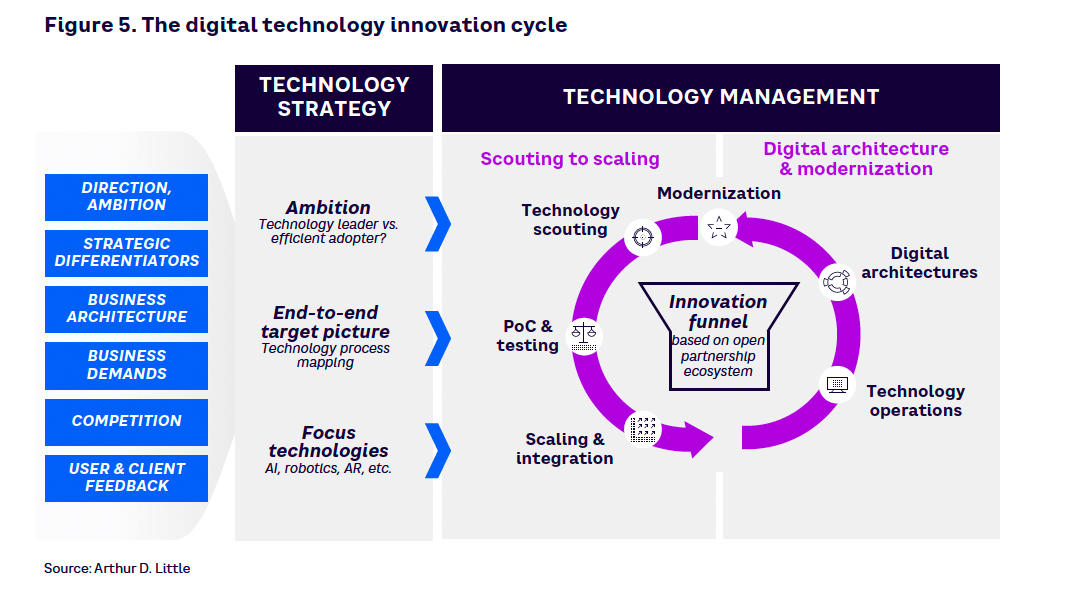
The starting point is to develop a digital technology strategy that defines clear ambitions and target end states, with roadmaps to set out short- and medium-term actions, and which technologies to focus on to achieve those actions. The target end states define technology/application objectives, building on the heatmap described above, and fleshing out how the range of digital building blocks maps onto operational processes. Assessing the financial benefits of each application is an important aspect. A balanced portfolio of projects can be established through mapping of parameters such as value versus feasibility, risk versus reward, scale of investment, and so on. A well-chosen digital technology use case can be applied to assist in this process.
A well-defined innovation funnel process needs to be established that recognizes phases like technology and ideas scouting, evaluation, PoC development, and scale-up/integration. One of the key aspects of any effective innovation process is that it should be based on an open partner ecosystem philosophy, meaning that external partners have a key role to play in each stage.
An effective technology scouting capability to monitor and rapidly assess developing technologies is important to feed the funnel. Scouting should be prioritized based on the strategy and project portfolio. However, this should be not only a rigid “top-down” exercise, but also a dynamic “bottom-up” approach to pick up on rapidly developing new opportunities that may not have been apparent at the strategy-setting stage.
Scaling and integration following the PoC stage are some of the most challenging aspects of the innovation cycle. There are some key success factors to consider:
- Focus only on a limited selection of technologies in a balanced portfolio at any one time — including some with high impact, a mix of established and emerging technologies, and at least some that are easy to implement.
- Ensure open communication, including showcase examples and engagement of staff, unions, and other stakeholders.
- Use agile organization and steering principles.
- Develop technology experts within the organization and leverage them to source additional use cases.
- Use venture capital logic for testing phases, with a clear focus on the business case throughout.
In all of this, the IT function should position itself as the spearhead of new technology use cases, sourcing, and adoption throughout the organization, in collaboration with the business.
Finally, developing the right architecture is central to the success of any digital innovation. An effective architecture is one that:
- Delivers speed and quality to the customer through automation, as well as differentiation through machine learning and artificial intelligence capabilities.
- Converges and integrates IT and operating technology (OT) in order to ensure seamless and secure transfer of data from the OT environment to the IT network and to ease data exposure for operational insights.
- Is simplified and standardized to reduce integration complexity and time to market for new features and functionalities.
- Provides context-relevant and open data as a service, avoiding silos, with enforced transparency on data lifecycle, data availability, and data-quality KPIs.
- Provides legacy system–independent services and platforms to facilitate new use cases, with common infrastructure to support scale and simplification.
- Ensures a single source of truth on data, single implementation per function, is cloud native, and offers security by design.
Monetizing IT assets
A business-driven architecture can also enable monetization of IT assets. There are four common types of opportunity for new revenue generation (see Figure 6). First, API access can be sold directly as a service to customers, or else used to deliver other services. For example, Telefonica sells anonymized and aggregated insights through secure APIs based on mobile data (e.g., crowd movements), sometimes charging a fee that can cover setup costs, consulting services, and API usage. Michelin created a new service to improve customer fleets’ efficiency, productivity, and environmental footprint by providing analyzed sensor data from tires and vehicles, delivered via APIs.
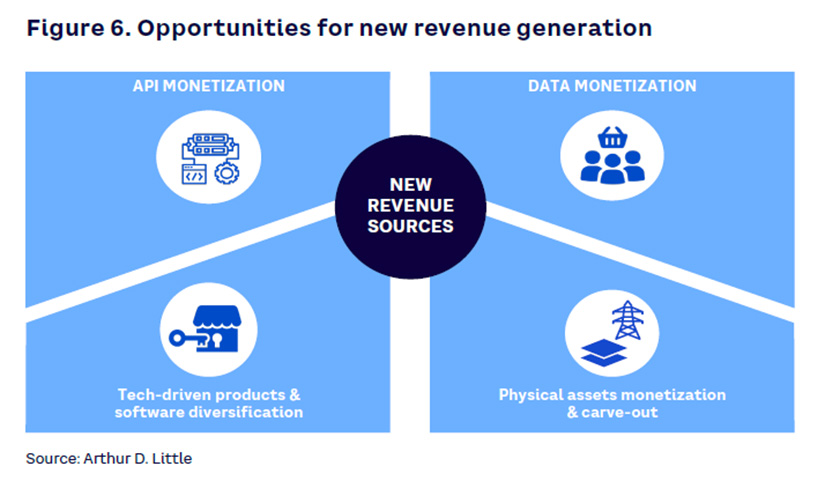
Second, there is often major value potential in combining and aggregating in-house and external sources of data to create new intelligence, insight, and information. This can lead to the formation of new data ecosystems, providing novel value-adding services. For example, recent ADL research shows that in the upstream oil industry, only 4% of data generated from exploration and production platforms is actually used. Competing companies (e.g., Shell, Chevron, and Exxon) have started to share operational data to improve predictive models for maintenance and downtime with mutual benefits.
Third, the acquisition of new digital technology software and hardware capabilities can in turn be used as a basis for new product innovation and diversification. For example, there may be new business opportunities that leverage recently acquired technology functionalities, such as new customer services enabled through better intelligence, connected products, or better matching of new products and services to customer needs, either through in-house capabilities or via collaboration with other partners in the digital ecosystem. In this area, more and more car manufacturers are embarking on the development of their own digital capabilities to develop not only the software for vehicle operations but also applications for vehicle-related and other added-value services. As an example, with its own vehicle operating system, its own automotive cloud, and a new electronic architecture in its vehicles, Volkswagen is gradually evolving into a software-driven mobility provider.
There may be parts of the new technology platform that could also be of value to external parties, and the associated value proposition may be distinctive enough to generate revenues. There are many examples, such as the recent Elia Group and Octopus Energy Group (UK) agreement to collaborate on consumer-centric energy flexibility services, leveraging technologies from each party to enable customer appliances like electric vehicles and heat pumps to balance the grid.
Fourth, there may be opportunities for monetization of assets associated with digitalization. This could include selling excess capacity, data, or cloud capabilities that could be of value to third parties. For example, in the rail industry, commercialization of excess broadband/fiber capacity is fairly common, with examples including Deutsche Bahn and SNCF. Carving out infrastructure assets typically requires some careful consideration, including how governance will be arranged, financial aspects, regulatory constraints, implementation complexities, and organizational implications.
conclusion
Insight for the executive
There are huge potential benefits in taking a structured, strategic approach to IT value creation in the context of the digitalization journey. This enables companies to break out of the vicious circle of ever-increasing operating costs and lack of investment for improvement and to perform the following five actions:
- Align their IT strategy with the three key ways that IT adds business value: efficiency, business alignment, and innovation.
- Decrease running costs to free up investment for change.
- Adopt a comprehensive approach for digital transformation, starting with strategy and governance, and including people and culture as well as technology.
- Focus especially on mastery across all the elements of the digital technology innovation cycle.
- Seek ways to monetize IT assets (e.g., through selling access to valuable data, creating new intelligence and information through data aggregation or manipulation, leveraging IT capabilities to offer new products and services, or selling excess capacity).
With all these actions, effective innovation is the key to unlocking IT value.




